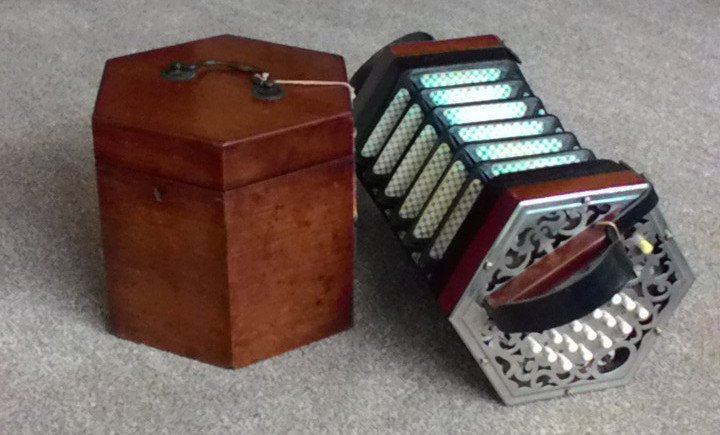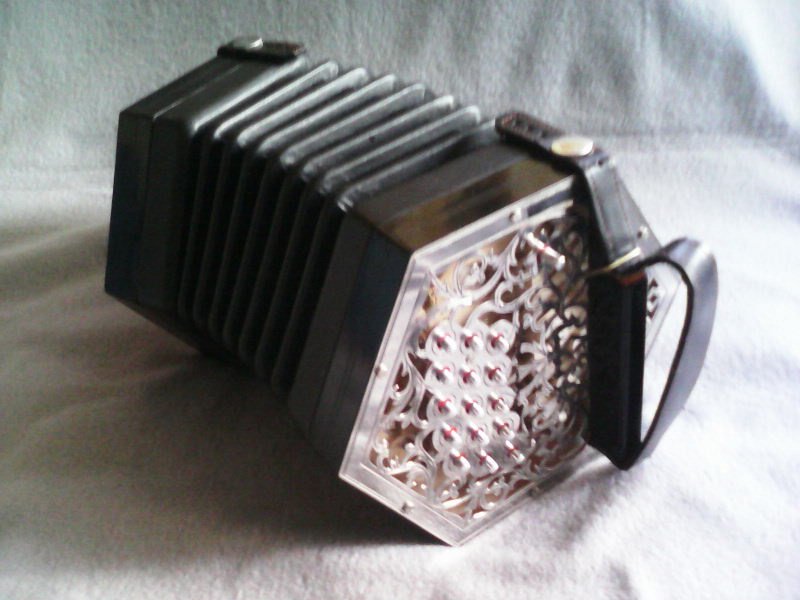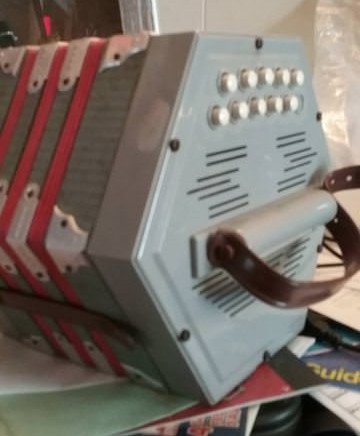-
Posts
1,287 -
Joined
-
Last visited
Everything posted by Roger Hare
-
Sorry, I have to ask... If he's enjoying the music that much, why is he lying on his back, legs in the air, 'playing dead'? Roger
-
The article on miniature and semi-miniature concertinas here contains several illustrations which appear to be of metal-ended concertinas. Later: Silly me! I should have posted pictures of my own metal-ended instruments: First: A modern Marcus G/D hybrid (Purchased from a member here about 3 years ago. This is the one I use for t'Morris - good and loud - blow yer socks off two counties away!) Second: A vintage George Jones C/G (Also purchased from a local parishioner. Serial number 20839, date?) Much later stil:. Ah! I now see that the OP related to metal-ends with additional fretting on the hexagonal edge/side of the wrap-around metal end (as opposed to a simple end-plate). I should have clocked that straight from the start I agolopise for muddying the waters... Roger
-
There are four short YouTube videos dealing with Scholers which may help you. They appear to be 20-button Anglos, and one of the models is triple-reeded, and another is tuned in D/A. See: https://www.youtube.com/watch?v=mbPw0yR19zM&index=1&list=PL777D961E7BDD0215 https://www.youtube.com/watch?v=88yCVla_Djg&index=2&list=PL777D961E7BDD0215 https://www.youtube.com/watch?v=Uvs4-ANFuq8&index=3&list=PL777D961E7BDD0215 https://www.youtube.com/watch?v=anBj1hibG0o&index=4&list=PL777D961E7BDD0215 Roger
-
This thread may point you in the right direction. I think that some of the (outdated?) information referenced in that thread points to about 1885-1895? I'm not an expert - maybe some-one with more knowledge than me will chip in... Roger
-

How to remove/replace 'rusted-in' screws?
Roger Hare replied to Roger Hare's topic in Instrument Construction & Repair
Not my problem - not my 'tina! ☺️ Thanks for the advice folks, I'll pass it on. Roger -
What is the best/safest way to remove end-plate screws which are 'rusted into place' without damaging the instrument? I put the inverted commas in because I thought that on most(?) 'tinas, the screws went straight into the wood, and thus cannot be 'rusted into place', whatever it is that is stopping them turning - just anno-domini, I expect... Ta. Roger
-
Yep! That looks like it - thanks very much!
-
-

drying out a concertina played in the rain
Roger Hare replied to Gail_Smith's topic in Instrument Construction & Repair
Our lead (melodeon) player wears a transparent plastic cagoule - very stylish, doesn't muffle the music too much, and our splendid musicians uniform can still be clearly seen... -
I think the apparent irregularity in the shape of the label might just be an optical illusion caused by irregularities on the lower edge of the hole in the wooden end? Roger
-
Don Taylor has Alan Day's audio lessons archived here: https://www.dropbox.com/sh/8mogrfx80c2usbk/AADzQV8rn1AYImD_fosryWfoa?dl=0 Just above the handstrap in the picture in the OP, there appears to be a horned face (attached). Looks like Old Nick to me - I've always said that concertinas were the work of the Devil. Scary...
-
Indeed! To muddy the waters even further, this old article by Ken Coles illustrates what looks like another similar instrument which is designated as a Renelli. The article is not primarily about this instrument, but is pretty interesting... I also found this comment: "You'll see pretty much (maybe identical) designs sold under the names "Bastari", "Stagi", "Silvertone", and other house-brand names. Generally all Italian-made, post-WWII and made in largely this design up to the present." in this 2016 thread. Roger
-

DC Ambiance - An Evening of Gypsy Jazz
Roger Hare replied to Randy Stein's topic in Public News & Announcements
Excellent. Ta. R- 5 replies
-
- english concertinq
- jazz manouche
-
(and 1 more)
Tagged with:
-

DC Ambiance - An Evening of Gypsy Jazz
Roger Hare replied to Randy Stein's topic in Public News & Announcements
My brother-in-law, who is a pretty mean GJ guitarist himself, and me, are both unable to make your gig (it's a long way from Manchester!). We both wonder if there is perhaps a CD in the pipeline? We've listened to the Soundcloud recordings, and want more... Roger.- 5 replies
-
- english concertinq
- jazz manouche
-
(and 1 more)
Tagged with:
-

Appcordions concertina apps - how to hold it right
Roger Hare replied to Don Taylor's topic in General Concertina Discussion
I had never given these programs any thought till I saw the photographs in ME's recent thread. I too was going to ask this question, but Don has beaten me to it! Just how do folks use these tablet-based concertina applications? -

Grace notes in ABC - Appoggiatura and Acciaccatura
Roger Hare replied to Roger Hare's topic in Teaching and Learning
That's what I wanted to hear. Thank you! That article is good - thank you. I just looked at the (few) examples of grace notes in my printed tune books. Most of 'em seem to be without the stroke, but I guess I now 'know' what I'm doing (hollow laughter...). Thanks both. Roger -
Thank you Don. In the Hugill version, there's a low A immediately after the C# - I don't have that A on my 26-button C/G, so the E in the version you posted will do very nicely as an alternative...
- 7 replies
-
- dreadnought
- sea shanties
-
(and 2 more)
Tagged with:
-
That MP3 is a seriously good version! Thanks for posting. Unfortunately the hand-cobbled ABC I have is melody only (and probably not very well remembered ). There's a score (again, melody only) on p. 346 of Stan Hugill's 'Shanties from the Seven Seas', Mystic Seaport, 1994, 0-913372-70-6. Hugill spells it 'Dreadnaught'. FWIW, 'Dreadnought' is not mentioned in Lubbock's 'The China Clippers'. I don't think she was a tea clipper, I think she she was a (mail?) packet on the Liverpool-New York run. Roger
- 7 replies
-
- dreadnought
- sea shanties
-
(and 2 more)
Tagged with:
-
There seem to be two ways to specify grace notes in ABC - {n} and {/n}. These are for Acciaccatura and Appoggiatura (*). The latter form produces a note with a stroke through the vertical bar. What I'd like to ask is: For 'folk/traditional music', does it matter which form is used? I tried both forms in a tune, and on playback, simply couldn't tell the difference... Ta. Roger (*) Highly technical, eh? - not sure I understand the difference, to be honest!
-
My pleasure - all part of the service! Slightly OT: I was involved (fairly peripherally) in maintaining a Wordpress-based site about 3 years ago - it was a bloody nightmare! R
-
> ...But in the meantime, Anglo players, I welcome your helpful comments... I couldn't quite see how to comment directly. The chord charts look pretty comprehensive. Ta! I don't play (much) ITM myself,(*) and I haven't looked at the whole site yet, but the pages look a little as if they are heading in that general direction? That's an observation, not a criticism, it all looks PDG to me. The part dealing with cross-rowing is nice. I too was scared of cross-rowing when I started (but I'm OK now). Your encouragement seems to me to be nicely pitched for encouraging newcomers to cross-rowing to cross that boundary. Thank you! Section on Terminology: Notes and buttons: > ...(T standing for 3rd row but some people call this the outside row, or accidentals row too)... Guilty as charged m'lud - please think of me as 'some people'. I've moved a fairly long way from the usual(?) row-naming convention. (Ooh! You rebel, you! ) Assuming we are talking about C/G instruments (I don't think that is explicitly stated in the page?), I have the 'accidental' row, the 'home' row and the 'G' row (on a G/D, that would be the 'D' row). I also number the buttons differently aL5->aR5 for the 'accidentals'; L5->R5 for the 'home' row and gL5->gR5 for the 'G' row (dL5->dR5 on a G/D). I don't know if other folks have developed 'their own' systems. (aside: might be interesting to find out?) Sounds clunky , but it works well when editing tabs into ABC scripts (if that's what floats your boat), and produces readable scores. Despite the fact that I'm using a non-standard row naming/button numbering systems, I don't have problems working with other systems so, once again, thank you for going to the trouble of putting this together. Roger (*)Not good enough yet!
-
FWIW, these seem to still be available as new items on ebay: https://www.ebay.co.uk/itm/Concertina-Accordion-20-Button-40-Reed-Anglo-Style-with-Carrying-Bag-O6H9/202364796811?hash=item2f1de1bf8b:g:zywAAOSwOZtbQvLG
-
There's a thread on melodeon.net which may be of relevance/interest in this context: http://forum.melodeon.net/index.php?topic=21990.0 Roger






